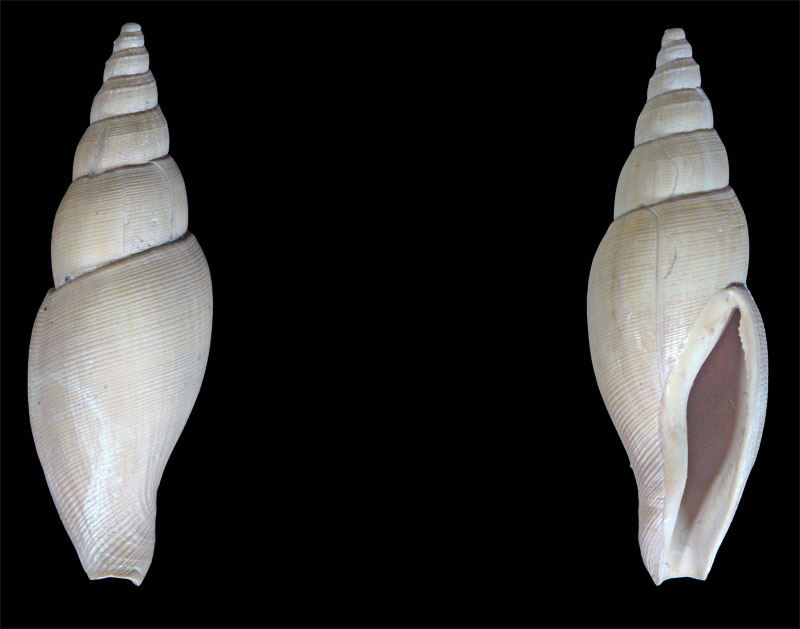|
|
|
|
|
Galleria Tassonomica
di
Natura Mediterraneo
|
|
|
| Autore |
 Discussione Discussione  |
|
|
Laser
Utente Senior
   

Città: Valle Mosso
Prov.: Biella
Regione: Piemonte

1685 Messaggi
Tutti i Forum |
|
|
emilio fossili
Utente Senior
   
Città: Pistoia
Prov.: Pistoia
Regione: Toscana

1240 Messaggi
Tutti i Forum |
 Inserito il - 15 giugno 2009 : 19:44:26 Inserito il - 15 giugno 2009 : 19:44:26


|
Esatto!
Ciao
Emilio |
 |
|
|
qbasic
Utente V.I.P.
  
Città: Gorla Minore
Regione: Lombardia

259 Messaggi
Tutti i Forum |
 Inserito il - 17 giugno 2009 : 09:34:38 Inserito il - 17 giugno 2009 : 09:34:38


|
prova a guardare questa discussione, forse trovi qualche cosa di interessante
Link
| Messaggio originario di Laser:
Mi potete confermare magari con testimonianze o caratteristiche di identificazioni ?
Pliocene Biellese, torrente Ostola (Masserano), 32 mm.
Immagine:

47,15 KB
Sergio
--------------------
Indagare per conoscere la natura è vivere (Settepassi)
|
|
 |
|
|
Laser
Utente Senior
   

Città: Valle Mosso
Prov.: Biella
Regione: Piemonte

1685 Messaggi
Tutti i Forum |
 Inserito il - 17 giugno 2009 : 18:23:12 Inserito il - 17 giugno 2009 : 18:23:12


|
Sono due giorni che Metula mitraeformis mi impegna al massimo.....può avere un sinonimo? è giusto la collocazione nella famiglia Buccinidae ?,il problema è che non la trovo citata in nessun lavoro inerente la fauna pliocenica biellese giungo alla conclusione che erroneamente l'abbia inserita nel posto sbagliato.

Sergio
--------------------
Indagare per conoscere la natura è vivere (Settepassi) |
 |
|
|
oxon
Moderatore
   
Città: genova
Prov.: Genova
Regione: Liguria

1958 Messaggi
Tutti i Forum |
 Inserito il - 17 giugno 2009 : 21:47:46 Inserito il - 17 giugno 2009 : 21:47:46


|
Direi che il posto è giusto, ma la denominazione passata era Acamptochetus mitraeformis.
Ciao.
Oxon
Give me the fruitful error any time, full of seeds, bursting with its own corrections. You can keep your sterile truth for yourself.
Vilfredo Pareto |
 |
|
|
Laser
Utente Senior
   

Città: Valle Mosso
Prov.: Biella
Regione: Piemonte

1685 Messaggi
Tutti i Forum |
 Inserito il - 18 giugno 2009 : 09:34:42 Inserito il - 18 giugno 2009 : 09:34:42


|
Ti ringrazio Oxon, ora è tutto chiaro, mi e tornato in mente anche il posto preciso del ritrovamento, non riuscivo a risalire ad Acamptochetus pensare che nel mio elenco è segnalato come sinonimo di Metula.
Unica a citarla è Luciana Andreoni nella sua tesi di laurea 1974 come Acamptochetus, possibile che il genere sia stato variato dopo tale data, come hai fatto risalire a questa variazione ? esistono testi per i fossili tipo Catalogo annotato del Sabelli ?
Sergio
Sergio
--------------------
Indagare per conoscere la natura è vivere (Settepassi) |
 |
|
|
oxon
Moderatore
   
Città: genova
Prov.: Genova
Regione: Liguria

1958 Messaggi
Tutti i Forum |
 Inserito il - 19 giugno 2009 : 21:57:03 Inserito il - 19 giugno 2009 : 21:57:03


|
Ciao Sergio,
alla sinonimia si risale chiaramente ddalla forma inconfondibile dei giri postembrionali, riguardo al nuovo nome mi sono adeguato ma non so da dove è saltato fuori.
Riguardo all'elenco esistono delle versioni locali, che, logicamente, risentono di questa loro peculiarità di essere locali, sia nelle faune che negli intendimenti degli Autori.
Sarebbe nostra intenzione, logicamente nelle more di tempi congrui e di adeguamenti sia strutturali che sistematici, tentare di darne, sempre con l'aiuto indispensabile di tutti gli utenti della sezione, una versione dinamica, pertanto si accettano suggerimenti da tutti.
L'inizio potrebbe essere quanto, a suo tempo, messo a disposizione da Emilio.
A presto.
Oxon
Give me the fruitful error any time, full of seeds, bursting with its own corrections. You can keep your sterile truth for yourself.
Vilfredo Pareto |
 |
|
|
Lucabio
Utente Senior
   

Città: Mongardino
Prov.: Asti
Regione: Piemonte

4359 Messaggi
Tutti i Forum |
 Inserito il - 20 giugno 2009 : 22:29:19 Inserito il - 20 giugno 2009 : 22:29:19


|
Caro Sergio,
so che è tutto in inglese, ma penso sia la spiegazione del perchè hai passato
due settimane a chiederti la provenienza del genere Metula, invece di Acamptochetus mitraeformis. Al di là dell'infinito discorso precedente sulle specie tipo in cui mi perdo anch'io, la parte conclusiva che ti ho messo in rosso e relativo riferimento all'articolo, penso sia quella fondamentale...
Tratto da: Link
Vol. 100 (1)
January 31, 1986
THE NAUTILUS 27
pt. 13, figs. 36-44 and catalogue published 1833).
Sykes, E. R. 1911. On the mollusca procured during the
"Porcupine" Expeditions, 1869-70. Supplemental Notes,
Part IV. Proc. Malac. Soc. London 9(6):331-348.
ON THE TYPE SPECIES OF METULA H. & A. ADAMS, 1853:
BUCCINUM CLATHRATUM A. ADAMS AND REEVE, 1850
(GASTROPODA: BUCCINIDAE)
William K. Emerson
Department of Invertebrates
American Museum of Natural History
New York, New York 10024
ABSTRACT
The type species o/Metula H. and A. Adams. 1853: Buccinum clathratum A. Adams and Reeve, 1850 (not Kiener, 183J,, nor Anton, 1839) is determined to be referable to Metula amosi Vanatta, 1913, from, the tropical eastern. Pacific. The genera Acamptochetus Cossmann, 1901; Antemetula Rehder, 19J,3; and Colubra-
rina Kuroda and Habe, in Kuroda, Habe, and Oyama, 1971, are placed in the synonymy of Metula.
The "Metula problem" has long been the concern of workers dealing with these buccinid gastropods owing to the uncertain nomenclatural and taxonomic status of the type species of this genus-group taxon (E. A. Smith, 1904; Woodring, 1928; Tomlin, 1927; Rehder, 1943; Altena, 1949; Knudsen, 1956; Cernohorsky,
1971; Olsson and Bayer, 1972, Kilburn, 1975; and Houbrick, 1984). This note undertakes to solve these questions.
The type of Metula, Buccinum. clathratum A. Adams and Reeve (1850, p. 32, pi. 11, fig. 12), was stated to have been dredged off the Cape of Good Hope, in 136 fathoms [248 meters] during the 1843-1846 voyage of the H.M.S. "Samarang". TomHn (1927, p. 160), in his review of the South American mollusks of the "St.
George" Expedition, however, noted that this species was: "Originally described from deep water off the Cape, but that locality, like many others in
the 'Samarang' work, is certainly erroneous." Furthermore, Tomlin (1927, op. cit.) concluded that this taxon was referable to specimens in his collection from Balboa, Panama, which he identified as "Metula clathrata (A. Ad. & Rve.)". Because later workers have largely ignored or questioned the identity of Buccinum clathratum A. Adams and Reeve, 1850, the type species oi Metula H. and A. Adams, I examined the holotypic specimen of this taxon, which is in
the British Museum (Natural History).
The specimen labeled as holotype of Buccinum clathratum. (BM(NH), 1874. 12. 1'l. 145; here illustrated, figures 1, 2) is 25.3 mm in height. The original polychrome illustration of the type (A. Adams and Reeve, 1850, pi. 11, fig. 12) depicts a specimen of the same size as the holotype, which is now faded and has a chip on the anterior portion of the outer lip.
As Cernohorsky (1971, p. 149) has pointed out, Bu.cci.num clathratum (A. Adams & Reeve, 1850) is twice preoccupied (not Kiener, 1834, p. 101, nor Anton, 1839, p. 91). Fortunately, a replacement name is not required, as Metula amosi Vanatta (1913, p. 22, figs. 1, 2; Keen, 1971, p. 566, fig. 1133; Olsson and Bayer, 1972, pp. 906, 907, figs. 1, B-D) is an available junior synonym of this taxon. The most common of the Panamic Metula, this species ranges offshore from the Gulf of California to Panama Bay.
Although large specimens attain more than 44 mm in height, mature examples of M. amosi in the American Museum of Natural History (AMNH) collection from Mexico and Panama are nearly as diminutive as the lioiotype of M. clathratn. Tomiin's (1927, op. cit.) referral of this species to Pacific Panamanian waters is thus confirmed, and the type locality of M. amosi is here restricted to Balboa, Bahia de Panama.
It should be noted that Knudsen (1956, pp. 39, 40, pi. 1, fig. 1) referred a specimen dredged off "Spanish Guinea", West Africa to Metula clatkrata (A. Adams & Reeve, 1850) (not Kiener, 1834, nor Anton, 1839). The specimen
figured by Knudsen is 47 mm in height (here reproduced, fig. 3) and is referable to an unidentified specimen of Metula in the AMNH collection (#198755; here illustrated, figs. 4, 5) from "West Africa", cx-Marcel Pin collection. Another record of this west African species, taken in 250 meters off Dakar, Senegal (Natal Museum J. 4152) was referred to me by Dr. R.
N. Kilburn. These specimens, however, are not conspecific with Metula clathrata (=M. amosi Vanatta) on the basis of the type specimen of A.
Adams and Reeve's M. clathrata (cf . figures 1 , 2 with figures 3-5), and they appear to represent a new species. Nor is Knudsen's west African
specimen referable to Metula boswellae Kilburn (1975, pp. 594, 595, fig. 10b, 10c), from off "MoQamhique", East Africa. Kilburn (1975, p. 592) accepted Knudsen's (1956, op. cit.) referral of the "Spanish Guinea" specimen to M.
clathrata (A. Adams & Reeve, 1850) and he noted that this taxon was preoccupied. Kilburn
(1975, op. cit.), therefore, renamed this taxon, Metula knudseni (Kilburn, 1975, p. 592). This unnecessary replacement name thus becomes a junior subjective synonym of Metula amosi Vanatta, 1913.
A number of authors have discussed the taxonomic status of Metula H. and A. Adams (1853, p. 84). Rehder (1943, p. 199) appears to be the first to attribute Metula clathrata (A. Adams and Reeve, 1850) as the type species (subsequent selection of Kobelt, 1876, p. 29, pi. 6, fig. 11 [ = "12"]). Woodring (1928, p. 286; 1964, p. 259; Keen, 1971, p. 566; Olsson and Bayer,
1972, p. 902) considered Buccinum metula Hinds, 1844, to be the type species by "hidden tautonymy," for which there is no provision in the ICZN Code.
Thus, this designation must be rejected (Cernohorsky, 1971, p. 149). Kobelt's
(1876, op. cit.) selection oi Metula clathrata, as the type species, therefore, appears to be the first available designation for Metula.
Cernohorsky (1971, pp. 151, 152) and Houbrick (1984, p. 420) considered Acamptochetus Cossmann (1901, p. 123) diwd Antemetula
Rehder (1943, p. 199) to be congeneric taxa. The type species of Acamptochetus, by original designation, is Murex mitraeformis Brocchi,
1814, from the Neogene of Italy and is a typical Metula (Cernohorsky, 1971, fig. 46). Other Neogene fossils are known from Europe, Java, Sumatra, India and the Americas (Altena, 1949;
Il lavoro sopra citato in cui si attribuisce Acamptochetus mitraeformis al genere Metula mitraeformis è il seguente:
Cernohorsky, W. O., 1971. Indo-Pacific Pisaniinae (Mollusca: Gastropoda) and related buccinid genera.
Records of the Auckland Institute and Museum 8:137-167, figs. 1-95.
Per cui credo che Luciana Andreoni nella sua tesi di laurea 1974 riporta ancora questa specie come Acamptochetus, sebbene il genere fosse stato variato prima di tale data, 1971, perchè verosimilmente o all'epoca il nuovo nome non era ancora entrato nell'uso comune o l'articolo non aveva avuto una grande diffusione! 
  
Luca
<<Non c'è niente come la paleontologia. Il piacere del primo giorno di caccia alla pernice o dell'apertura della stagione della caccia non si può paragonare a ciò che si prova nel trovare un gruppo di ossa fossili in buono stato, che raccontano la loro antica storia in un linguaggio quasi vivo>>. Charles Darwin
Link |
 |
|
| |
 Discussione Discussione  |
|
|
|
 Natura Mediterraneo Natura Mediterraneo |
© 2003-2024 Natura Mediterraneo |
 |
|
Leps.it | Herp.it | Lynkos.net
|

 Forum
|
Registrati
|
Msg attivi
|
Msg Recenti
|
Msg Pvt
|
Utenti
|
Galleria |
Map |
Forum
|
Registrati
|
Msg attivi
|
Msg Recenti
|
Msg Pvt
|
Utenti
|
Galleria |
Map |